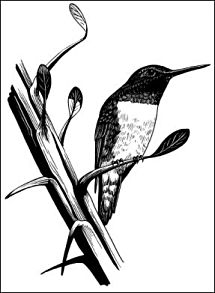
Ah, Hummingbirds! How would it feel to be one? Just imagine the wonderful freedom that comes from zipping through the air at lightning speed, hovering at will, and being cocky enough to dive-bomb intruders, be they cat, human, or even other hummers. But all this comes with a high price.
The tiny body of a hummingbird burns its fuel at a tremendous rate. Plants that depend on them as pollinators have to provide large amounts of high-energy nectar, and the birds must feed almost constantly to meet their energy requirements.
One bird who inadvertently found itself trapped in El Paso's Centennial Museum flew around wildly until it was too exhausted to fly anymore. At that point, the museum curator, Scott Cutler, was able to capture it, and luckily, there were many hummingbird plants available around the museum. Scott carried the bird from one flower to another until it regained enough energy to fly away.
Fun to be a hummer? Perhaps, but even these feisty little birds occasionally need a helping hand.

Contributor: Kodi R. Jeffery, formally of the Centennial Museum, University of Texas at El Paso.
Desert Diary is a joint production of the Centennial Museum and KTEP National Public Radio at the University of Texas at El Paso.

Drawing of a Black-chinned Hummingbird (Archilochus alexandri) by Zackery Zdinak (© 1999).
Welty, J. C. 1982. The life of birds. Sanders College Publishing, Philadelphia, 754 pp. (Virtually any textbook on birds will serve).